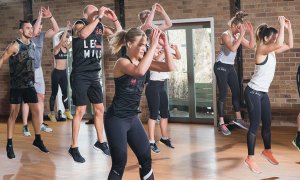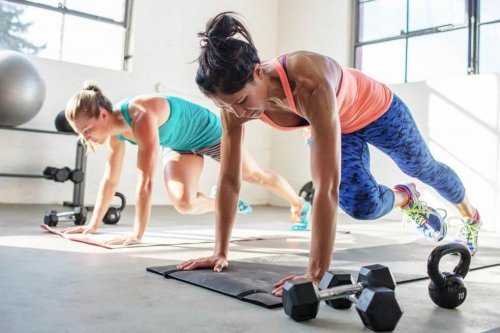HIIT For Beginners

Those who are bored with the usual aerobic routines can now try a new workout format that has already captured many followers. This new format is a great option for those who go to the gym and want to start a training routine. Let’s see what HIIT for beginners looks like.
What is HIIT?
HIIT (which stands for High Intensity Interval Training) combines intense exercises with other less intensive ones, during which the body recovers. This alternation allows for the workout to be bearable, fun and very effective. It’s specially chosen by those who are beginners in the world of aerobics. Every day more people are deciding to add the HIIT beginner routines to their way of life.
Because of the interesting nature of the exercises and its characteristics, it’s less likely that someone will want to give up such an activity.
While many people stop going to the gym after some sessions of traditional training, with HIIT there are extra reasons not to.
HIIT benefits

This innovative method to workout allows you to achieve interesting goals at both, an aesthetics level and a health level. Its most relevant characteristics are:
- It’s a very effective program to lose weight and burn great quantities of fat. It involves calorie burning both during the workout, and in the hours following.
- Works your strength and resistance, therefore your muscles and breathing will strengthen. This also boosts your muscle building.
- It contributes to balancing blood pressure, which is why HIIT is recommended for people with hypertension.
- Favors cardiorespiratory fitness and increases your maximum VO2, which is your capacity to absorb oxygen. Therefore, you are more resistant during any physical activity.
- Increases insulin production. By doing HIIT you reduce your probability of getting diabetes.
- Stimulates hormone production: testosterone and growth hormone.
- Helps with the balance of cholesterol, reducing the “bad one” and increasing the “good one”.
- Saves time. A HIIT session requires much less time than a conventional aerobic routine.
What’s important when starting HIIT?
HIIT routines are very enticing since they give great results in a short time, two really appealing features. Now, as with every physical activity, you must move forward gradually, in terms of intensity.
There are people who have never done any type of physical activity or have stopped exercising for some time and have decided to start again; to those people the advice is, to start with a HIIT beginners routine that will avoid any health risks. You’ll be doing exercises that you should gradually introduce, in order to avoid pain and injury.
It’s possible for beginners to track their HIIT training with a heart rate monitor. There’s a formula to estimate this reference: max HR=220-age. This will give you a value to track your exercise.
But the best advice is to pay attention to what your body is telling you.
During high intensity moments, we suggest that you put in your maximum effort, while during the low intensity ones, the idea is to rest and lower your heart rate.
Examples of HIIT exercises for beginners

As with every sport, HIIT training starts with warm-up exercises, essential to avoiding injuries.
So, you’ll need to perform gentle movements such as, walking and jogging, for example. Thus the body gradually prepares itself for the action.
- Do high knee lifts as many times as you can, for 15 seconds. This technique is also good for runners. You should do it standing in the same spot and landing very lightly.
- Secondly, alternate punching right and left, at a low speed. The hips go with the arm movements (one minute).
- High knee lifts with a jump, at a high speed (15 seconds).
- Half burpee at a high intensity (15 seconds). To start, use the plank position. Lift your body up, with the support of your hands and the tips of your toes. With a jump, bring your feet to your hands.
- High knee lifts at a low speed (15 seconds).
- Squat jumps at a high speed (15 seconds).
- Walking at a low pace (one minute).
Also, it’s possible to do other variations of the exercises, maybe alternating them by throwing a ball to the wall, or using dumbbells. The fundamental thing is to alternate between intensities in short periods of time, then increase your rhythm progressively.
Those who are bored with the usual aerobic routines can now try a new workout format that has already captured many followers. This new format is a great option for those who go to the gym and want to start a training routine. Let’s see what HIIT for beginners looks like.
What is HIIT?
HIIT (which stands for High Intensity Interval Training) combines intense exercises with other less intensive ones, during which the body recovers. This alternation allows for the workout to be bearable, fun and very effective. It’s specially chosen by those who are beginners in the world of aerobics. Every day more people are deciding to add the HIIT beginner routines to their way of life.
Because of the interesting nature of the exercises and its characteristics, it’s less likely that someone will want to give up such an activity.
While many people stop going to the gym after some sessions of traditional training, with HIIT there are extra reasons not to.
HIIT benefits

This innovative method to workout allows you to achieve interesting goals at both, an aesthetics level and a health level. Its most relevant characteristics are:
- It’s a very effective program to lose weight and burn great quantities of fat. It involves calorie burning both during the workout, and in the hours following.
- Works your strength and resistance, therefore your muscles and breathing will strengthen. This also boosts your muscle building.
- It contributes to balancing blood pressure, which is why HIIT is recommended for people with hypertension.
- Favors cardiorespiratory fitness and increases your maximum VO2, which is your capacity to absorb oxygen. Therefore, you are more resistant during any physical activity.
- Increases insulin production. By doing HIIT you reduce your probability of getting diabetes.
- Stimulates hormone production: testosterone and growth hormone.
- Helps with the balance of cholesterol, reducing the “bad one” and increasing the “good one”.
- Saves time. A HIIT session requires much less time than a conventional aerobic routine.
What’s important when starting HIIT?
HIIT routines are very enticing since they give great results in a short time, two really appealing features. Now, as with every physical activity, you must move forward gradually, in terms of intensity.
There are people who have never done any type of physical activity or have stopped exercising for some time and have decided to start again; to those people the advice is, to start with a HIIT beginners routine that will avoid any health risks. You’ll be doing exercises that you should gradually introduce, in order to avoid pain and injury.
It’s possible for beginners to track their HIIT training with a heart rate monitor. There’s a formula to estimate this reference: max HR=220-age. This will give you a value to track your exercise.
But the best advice is to pay attention to what your body is telling you.
During high intensity moments, we suggest that you put in your maximum effort, while during the low intensity ones, the idea is to rest and lower your heart rate.
Examples of HIIT exercises for beginners

As with every sport, HIIT training starts with warm-up exercises, essential to avoiding injuries.
So, you’ll need to perform gentle movements such as, walking and jogging, for example. Thus the body gradually prepares itself for the action.
- Do high knee lifts as many times as you can, for 15 seconds. This technique is also good for runners. You should do it standing in the same spot and landing very lightly.
- Secondly, alternate punching right and left, at a low speed. The hips go with the arm movements (one minute).
- High knee lifts with a jump, at a high speed (15 seconds).
- Half burpee at a high intensity (15 seconds). To start, use the plank position. Lift your body up, with the support of your hands and the tips of your toes. With a jump, bring your feet to your hands.
- High knee lifts at a low speed (15 seconds).
- Squat jumps at a high speed (15 seconds).
- Walking at a low pace (one minute).
Also, it’s possible to do other variations of the exercises, maybe alternating them by throwing a ball to the wall, or using dumbbells. The fundamental thing is to alternate between intensities in short periods of time, then increase your rhythm progressively.
This text is provided for informational purposes only and does not replace consultation with a professional. If in doubt, consult your specialist.








